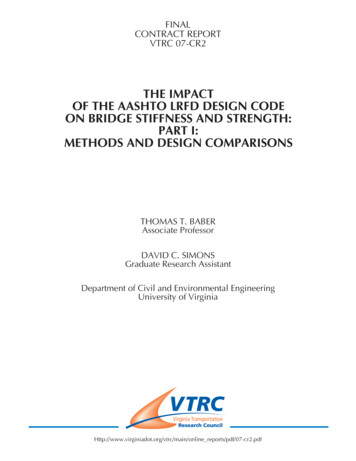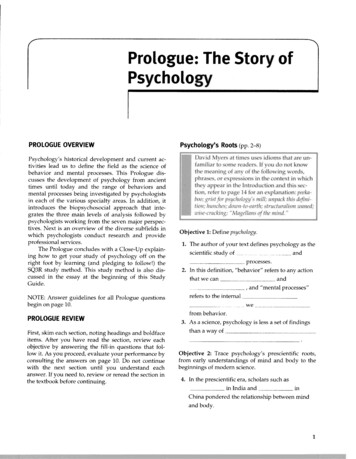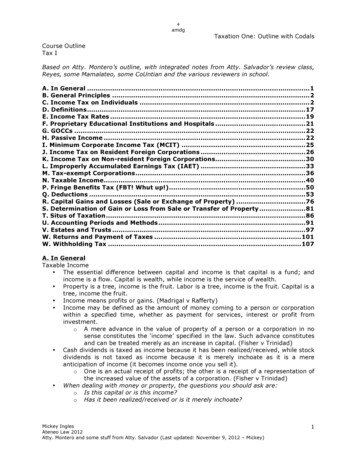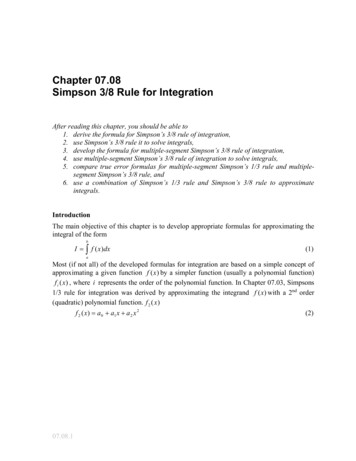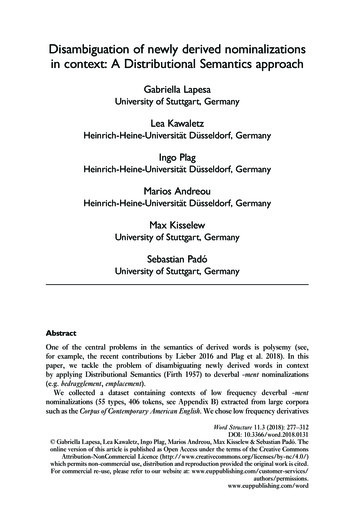
Transcription
Disambiguation of newly derived nominalizationsin context: A Distributional Semantics approachGabriella LapesaUniversity of Stuttgart, GermanyLea KawaletzHeinrich-Heine-Universität Düsseldorf, GermanyIngo PlagHeinrich-Heine-Universität Düsseldorf, GermanyMarios AndreouHeinrich-Heine-Universität Düsseldorf, GermanyMax KisselewUniversity of Stuttgart, GermanySebastian PadóUniversity of Stuttgart, GermanyAbstractOne of the central problems in the semantics of derived words is polysemy (see,for example, the recent contributions by Lieber 2016 and Plag et al. 2018). In thispaper, we tackle the problem of disambiguating newly derived words in contextby applying Distributional Semantics (Firth 1957) to deverbal -ment nominalizations(e.g. bedragglement, emplacement).We collected a dataset containing contexts of low frequency deverbal -mentnominalizations (55 types, 406 tokens, see Appendix B) extracted from large corporasuch as the Corpus of Contemporary American English. We chose low frequency derivativesWord Structure 11.3 (2018): 277–312DOI: 10.3366/word.2018.0131 Gabriella Lapesa, Lea Kawaletz, Ingo Plag, Marios Andreou, Max Kisselew & Sebastian Padó. Theonline version of this article is published as Open Access under the terms of the Creative CommonsAttribution-NonCommercial Licence /)which permits non-commercial use, distribution and reproduction provided the original work is cited.For commercial re-use, please refer to our website at: rmissions.www.euppublishing.com/word
278GABRIELLA LAPESA ET AL.because high frequency formations are often lexicalized and thus tend to not exhibitthe kind of polysemous readings we are interested in. Furthermore, disambiguatinglow-frequency words presents an especially difficult task because there is little to noprior knowledge about these words from which their semantic properties can beextrapolated.The data was manually annotated according to eventive vs. non-eventiveinterpretations, allowing also an ambiguous label in those cases where the context didnot disambiguate. Our question then was to what extent, and under which conditions,context-derived representations such as those of Distributional Semantics can besuccessfully employed in the disambiguation of low-frequency derivatives.Our results show that, first, our models are able to distinguish between eventiveand non-eventive readings with some success. Second, very small context windows aresufficient to find the intended interpretation in the majority of cases. Third, ambiguousinstances tend to be classified as events. Fourth, the performance of the classifier differedfor different subcategories of nouns, with non-eventive derivatives being harder toclassify correctly. We present indirect evidence that this is due to the semantic similarityof abstract non-eventive nouns to eventive nouns. Overall, this paper demonstrates thatdistributional semantic models can be fruitfully employed for the disambiguation of lowfrequency words in spite of the scarcity of available contextual information.1Keywords: distributional semantics, nominalization, disambiguation, English,suffix -ment1. IntroductionIn many languages polysemy in word-formation is all-pervasive (e.g. Rainer 2014).Bauer et al. (2013), Kawaletz & Plag (2015, 291), Lieber (2016, 18f), for example, comeup with lists of readings available to English deverbal nominalizations involving thesuffixes -ing, -ation, -ment, -ance/-ence, -th and conversion, similar to the one givenin Table 1. Other languages show similar patterns of polysemy, for example French(Uth 2011; Fradin 2011, 2012a,b), Italian (Melloni 2011) or German (Roßdeutscher &Kamp 2010; Roßdeutscher 2010; Brandtner 2011).Given the variety of interpretations that derivatives of a given affix can giverise to, how do listeners find the right reading? This is not a trivial task, especiallyif we consider derivatives that are newly coined, or so infrequent that it is highlyunlikely that listeners have stored available readings for these forms. And even if they do,1This work has benefited from discussions with the audiences at COST (Cognitive Structures, September15–17, 2016, Heinrich-Heine-Universität Düsseldorf) and at Mediterranean Morphology Meeting 11(June 22–25, 2017, Nicosia). We gratefully acknowledge that this research has in large parts been funded bythe Deutsche Forschungsgemeinschaft (DFG Collaborative Research Centre 991, Project C08 “Thesemantics of derivational morphology: A frame-based approach”, awarded to Ingo Plag; DFGCollaborative Research Centre 732, Project B9 “Distributional Characterization of Derivation”, awardedto Sebastian Padó).
279D I S A M B I G U AT I O N O F N E W LY D E R I V E D N O M I N A L I Z AT I O N STable 1: Readings of English nominalizationsSemantic �the event of V-ing’‘the outcome of V-ing’‘the thing that is created by V-ing’‘the thing that V-s’‘the place of V-ing’‘people or person who V-s’‘how much is V-ed’‘the direction of V-ing’‘the thing affected or moved by V-ing’‘the state of V-ing or being V-ed’‘an instance of V-ing’production, trainingacceptance, alterationpavement, growthseasoning, advertisementdump, residenceadministration, cookpinch, decelerationdecline, directioncatch, acquisitionalienation, disappointmentbelch, cuddlea given form still can have different stored readings. Thus, it seems that thecontext in which a given form occurs must provide the necessary cues that help listenersto come up with the reading that is actually intended by their interlocutor who usesthe word.In her recent book on nominalizations, Lieber (2016: 8) formalizes the workof the context in deriving a particular reading as ‘Contextual Coercion’, ‘by whichspecific readings of those words are realized in specific syntactic contexts’. Thenotion of Contextual Coercion is very similar to Pustejovsky’s ‘accommodationsubtyping’ (Pustejovsky 2011: 1411). In this view, an inherently underspecifiedor unspecified semantic feature (for example [material]) is fixed to one value(for example [ material]) on the basis of other information available in the syntacticcontext. Let us use an example from Lieber (2016: 122ff.) for illustration. The exampleis taken from the Corpus of Contemporary American English (COCA, Davies 2008),emphasis ours.(1) The Guggenheim, considered the generator of 80 percent of Bilbao’s 1 millionannual tourists (Calvo 2001b), provided President Fraga with an example ofa successful construction that helped to remake a city’s image. (COCAACAD 2012)In this case, encyclopedic knowledge and the definite article tells the reader thatThe Guggenheim refers to a museum, which, via Contextual Coercion, leads to theinference that construction must be concrete and inanimate, which fixes the value of thefeature [material] to [ material]. It should be noted, however, that an alternativeinterpretation (not mentioned by Lieber) still seems possible. Thus, a city’s imagecan not only be remade by having a nice new building, but also by successfullybuilding one. For example, the city of Berlin’s image has seriously suffered from the
280GABRIELLA LAPESA ET AL.problems surrounding the construction (event reading!) of the new airport BER, and asuccessful construction (event reading!) of some other building may boost Berlin’s imagein this domain.The example nicely shows that sometimes larger contexts and very specific sharedknowledge may need to be fed into the construal or disambiguation of the meaning ofpolysemous derivatives. If such knowledge is not available or not clearly alluded to,listeners and readers may be stuck with ambiguous or underspecified meanings. Theliterature (e.g. Bauer et al. 2013; Lieber 2016; Andreou 2017) often discusses individualcases of disambiguation, but it is currently unclear to what extent, across manyderivatives and contexts, the syntactic context of derived words actually helps todisambiguate a given derivative.There is also a more general theoretical problem involved in approachingthe interpretation of complex words that we have glossed over so far, i.e. what wemean more specifically by ‘disambiguation’. Do we mean the selection of a particularmeaning among some lexically listed meanings? Or the construal of one particularreading on the basis of different sources of information? Especially with regard tomorphologically derived words, this is a vexed issue, since the interplay between affixand base may sometimes lead to lexically fixed possibilities of meaning (especially withestablished derivatives), and may sometimes necessarily involve the construal ofmeanings based on the semantic representations of base and affix (especially withnovel forms). This problem will be discussed in more detail in §2. For the purposes ofour study, a broad notion of disambiguation as ‘finding the right reading’ is used whichallows for both possibilities mentioned.In this paper, we empirically explore, for words derived with the suffix -ment inEnglish, to what extent syntactic contexts provide the necessary cues for disambiguation.We will do so for newly derived and rare derivatives, for which readers and listeners donot have fixed meanings available. These cases are especially interesting because theynecessarily involve the construal of meaning instead of retrieving attested interpretationsfor whole words from the mental lexicon. At the same time, this makes disambiguation aneven harder task.For our exploration, we adopt a corpus-based methodology developed to deal withmeaning in context, distributional semantics (Firth 1957; Miller & Charles 1991;Schütze 1998). In this approach, the meaning of a word is represented as a vector whichmathematically expresses the co-occurrences of this word with very many other words ina given corpus (see §5.1 for details and explanation). Distributional semantics has beenused successfully to model various aspects of lexical semantics. However, in the domainof morphological derivation there is only little work using distributional semantic tools.For example, Cotterell & Schütze (2017) is a general approach to use vector semantics formorphological segmentation, and Kisselew et al. (2016) employ distributional semanticsto determine the directionality of conversion. Some scholars (e.g. Marelli 2015)investigated the transparency of morphological categories, or the semantic differencesbetween certain suffixes (Varvara 2017). To our knowledge, the present paper is the firstdistributional semantic approach to tackle the problem of disambiguation of newlyderived words.
D I S A M B I G U AT I O N O F N E W LY D E R I V E D N O M I N A L I Z AT I O N S281Focusing on only two readings, EVENTIVE and NON-EVENTIVE, we used distributionalsemantic models to predict the interpretations of a sample of newly derived -mentderivatives in their sentential context (55 types, 406 tokens from COCA, see Appendix Bfor a list of the types). We then compared the predicted interpretations with theinterpretations that we had annotated manually.The paper is structured as follows. In the next section we will clarify the notion ofdisambiguation to set the theoretical scene for our investigation. §3 lays out our task, and§4 introduces the dataset and coding. §5 introduces our distributional semantic tools andtheir implementation, followed in §6 by the presentation of the results. The final sectionsummarizes and discusses our results.2. Ambiguity, disambiguation and the construal of meaningOne of the central problems in the study of the semantics of derivation is ambiguity. Thatis, derived formations can be interpreted in more than one way (Rainer 2014; Szymanek2013; Lieber 2016; Plag & Balling forthcoming; Andreou 2017). There are several kindsof ambiguity that relate to the internal structure of derived words, to lexicalization, or tocontextual factors.One kind of ambiguity is structural in nature and arises through the possibility ofassigning two different internal hierarchical structures to the same string. This is called‘structural ambiguity’ (e.g. Szymanek 2013) or ‘compositional ambiguity’ (e.g. Löbner2013, 48). For instance, the derived word unlockable may be interpreted in two waysdepending on the internal hierarchical structure one ascribes to it. In particular, thebracketing in (2a) derives the reading ‘which cannot be locked’, whereas the bracketingin (2b) gives rise to the reading ‘which can be unlocked’. (2c) and (2d) give a syntacticexample, in which the interpretation of who has the telescope depends on thesyntactic parsing.(2) a.b.c.d.[un-[[lock]-able]][un-[lock]]-able]I [saw [the man with a telescope]].I [saw [the man] [with a telescope]].In this paper we do not address structural ambiguity.Another kind of ambiguity relates to the semantic representation of lexical items and isoften called ‘lexical ambiguity’. This type of ambiguity comprises two major sub-types,homonymy and polysemy. In cases of homonymy, two lexemes share all properties(e.g. sound form and grammatical category) but have unrelated meanings. Thus, casessuch as bank1 ‘a financial establishment’ and bank2 ‘edge of a river’ (paraphrases takenfrom the Oxford English Dictionary) are considered as distinct entries in the lexicon.In contrast to homonymy, in which different readings of the same form are attributedto different lexemes, in polysemy, the various readings are considered as variants ofthe same lexeme. Consider, for example, the derived government. It has a number ofreadings including ‘the continuous exercise of authority over a person, group, etc.’,
282GABRIELLA LAPESA ET AL.‘a period of rule’, and ‘the body of people charged with the duty of governing’(paraphrases taken from the OED). Crucially, all readings are interrelated and consideredas variants of the same lexeme, namely government.Finally, ambiguity arises with the use of lexemes in context (Asher 2011; Lieber2016; Andreou 2017). The context may eliminate particular readings of a lexeme, ormodify its meaning. In the case of meaning modification, the context enriches themeaning of a lexeme and triggers meaning shifts. This is often referred to as ‘coercion’.The context, for example, may cause a lexeme to be interpreted metonymically ormetaphorically.Verbs may determine the interpretation of the nouns that head their complementsthrough selectional preference and vice versa (‘co-composition’, Pustejovsky 1995: 122f,223). For instance, read the book evokes the ‘text’ interpretation of book, while weigh thebook triggers the interpretation as a physical object. Conversely, in bake the cake the verbbake is interpreted as a verb of creation due to the object noun cake, whereas in bake thepotato as a change of state verb due to the object noun potato. In other cases, referred to as‘co-predication’ (Asher 2011), not just one but both senses of a polysemous word areselected in the same utterance. Consider the sentence Lunch was delicious but it tookforever: both the object and the eventive reading of lunch are selected in the samesentence.Such examples of coercion or co-composition bring a further element into ourdisambiguation picture, which will be crucial throughout our study, namely the needof a pre-established set of senses to which the disambiguation target can be assigned.Whether one defines such senses as ‘types’ as in Pustejovsky (1995), or as ‘aspects’(see Asher 2011), the introduction of a sense inventory allows the researcher to model thecontextual dynamics of disambiguation in a more constrained way. Additionally, takingthe perspective of disambiguation within a sense inventory uncovers a fundamentalfeature of polysemy: its systematicity. Some nouns (defined as ‘dot-types’ or ‘dualaspect’), come with a specified pairing of meanings (e.g. book as both object and pieceof information) and in some contexts, crucially, both these meanings are selected atthe same time. In John read the book the action of reading applies to both the objectand the communication, as opposed to The book fell, in which only the object typeis selected.A basic difference between contextual ambiguity and polysemy is that in contextualambiguity, the various readings are not necessarily lexically stored but may be construedonline. The distinction between contextual ambiguity and polysemy is fuzzy and, moreoften than not, a metonymical or metaphorical reading of a lexeme may be stored in thelexicon. This is, for example, the case with government in which various readings that arelinked by meaning shift mechanisms such as metonymy were lexicalized and, thus, storedas meaning variants of the lexeme in question.The problem of disambiguation is particularly salient in derived words since theincreased number of meaningful elements and their interaction opens up even morepossibilities of interpretation than is the case with monomorphemic words. Forillustration, consider the interpretation of prefixal negation with un-. A pertinent form,un-diva, is given with its context in (3).
D I S A M B I G U AT I O N O F N E W LY D E R I V E D N O M I N A L I Z AT I O N S283(3) Dawn Upshaw has been called the “un-diva” of the opera world, often preferring toperform innovative, relatively obscure works that emphasize words over music in aninformal style, often - imagine this - even chatting with an audience at recitals.(COCA SPOK 1994)Dawn Upshaw, ‘the “un-diva” of the opera world’, is actually a diva who breaks down thestereotype for the category DIVA. Thus, she is not a stereotypical member of the categoryDIVA. In (3), the use of the prefix un- with diva informs us that the derived word has aflavor of negativity, but it is not until the derived un-diva is embedded into the particularcontext in (3) that its reading is fixed. In particular, contextual cues such as ‘preferringto perform innovative, relatively obscure works that emphasize words over music in aninformal style’, and ‘even chatting with an audience’ modify and enrich the meaning ofthe derived word un-diva.This means that in (3), two kinds of ambiguity co-exist. First, there is the ambiguityof the prefix un-. This prefix has a number of readings. It may give rise to contrary andcontradictory readings on adjectives (e.g. unfriendly, undeniable) and reversative readingson verbs (e.g. unlock). On nouns it derives stereotype negation and general negativereadings. If one opts for a polysemous analysis of all these readings, then the variousreadings are treated as variants of the same prefix. If one opts for an analysis based onhomonymy, then the various readings are attributed to more than one un- prefix. In anycase, the interaction of the prefix with its base narrows down the range of possibleinterpretations.The second kind of ambiguity is contextual in nature. It is the context that enriches themeaning of un-diva and guides us towards the right interpretation, i.e. stereotypenegation instead of general negation (see Andreou 2017 for a discussion of stereotypenegation).Given these problems in interpreting derived words, one would like to knowhow exactly the context feeds into the interpretation of newly derived words.The literature on derivational semantics often discusses individual cases (see Baueret al. 2013; Lieber 2016 for many examples), but there is no study available thatinvestigates the problem on a more systematic and large-scale empirical basis. Brandtner(2011) investigates different readings of German -ung nominalizations in contextand comes up with a taxonomy of what she calls ‘indicators’, i.e., the contextual cuesthat may guide the reader to a particular interpretation of a derived word.For example, DP modifiers referring to size, shape, weight, or internal structure aregood indicators of result objects (e.g. lang, rot, schwer ‘long, red, heavy’, 200 Teileumfassend ‘consisting of 200 parts’, Brandtner 2011: 50). Such indicators can do theirwork because their ‘selectional restrictions can disambiguate the nominal if theyonly allow for one of the readings available for it and lead to sortal mismatches with theothers.’The present paper does not want to investigate in detail the ways by which semanticmechanism individual indicators may help to disambiguate new derivatives. Rather, weare interested in the empirical question of how successfully the general contexts of rare ornewly derived words actually allow for disambiguation.
284GABRIELLA LAPESA ET AL.3. Disambiguating -ment derivatives in contextThe crucial assumption behind our approach is that the context reduces the number ofpossible readings by eliminating certain readings and, quite often but not necessarily,forces one reading for a given lexeme. This means that the various readings of anambiguous lexeme appear in different types of context. Let us illustrate this with themonomorphemic lexeme window in (4), for which the OED lists more than 20 differentinterrelated meaning variants.(4) a. They can say all they want, that this shows a lot of people are interested.But they’ve got a very short window here, a couple of months. And if they don’tget the 7 million people, including a large number of healthy people, this systemwill not work. (COCA SPOK 2013)b. I clicked the SUBMIT button. Nothing happened. Not at first. The programopened a new window and a message appeared across the top. (COCA FIC 2015)c. He has no dog in the fight and can’t understand why the city would tear it down.“They are harassing poor people about putting on a new window - well a newwindow is a big project,” he said. Blanchard knows people who were forced tosell because they couldn’t keep up with Pagedale’s code. (COCA NEWS 2015)As evident in the examples in (4), the meaning variants of window may appear in differenttypes of contexts. Thus, based on the contextual information ‘a couple of months’,we infer that the meaning variant of window that appears in (4a) relates to time, and canbe paraphrased as ‘an interval of time which affords an opportunity to perform aparticular action, or within which a particular action must be performed’. In (4b), severalcontextual cues such as ‘clicked the SUBMIT button’ and ‘the program opened’ relateto computing, and force the reading ‘a rectangular, typically framed area of the displayscreen that is produced by a graphical user interface in order to display information,an image, or an interface for an application.’ Finally, the contextual information ‘tear itdown’ and ‘putting on’ in (4c) guide us towards the reading ‘an opening in the wall orroof of a building, for admitting light or air and allowing people to see out; [ ] theglazed frame intended to fit such an opening’.As pointed out in §2, the issue of ambiguity is particularly relevant for words thatresult from the application of a derivational process to a base. The role of the base increating multiple meanings is, however, not restricted to potential consequences of basepolysemy. The semantic representation of the base itself may also be the source ofcompeting interpretations. This can be nicely explained in terms of referential shifts(Löbner 2013). Derivational semantics can be conceptualized as meaning shifts insemantic representations (e.g. Kawaletz & Plag 2015). In particular, reference is shiftedfrom the original referent of the base to a new referent of the derivative. For example, inthe case of agentive -er formations reference can be shifted from the event (expressed bythe verb) to the subject argument of the verb, or to other entities involved in the event(e.g. its location, as in diner, or an instrument, as in printer). For -ment, it has been shownthat such shifts away from the verbal eventive interpretation can target, for example, the
D I S A M B I G U AT I O N O F N E W LY D E R I V E D N O M I N A L I Z AT I O N S285stimulus argument or the result state in the case of psych verbs (Kawaletz & Plag 2015).Other types of verb may have other kinds of semantic entities to which reference canshift, e.g. the patient in the result state (Plag et al. 2018). In this way, the semantics of theverbal base has an impact on which readings are possible or likely with -ment forms andwhich ones are not.In this paper we will empirically explore the extent to which the contextsurrounding newly derived words with the suffix -ment provides the necessary cuesfor disambiguation. The task at hand is particularly difficult because newly derivedwords are often ambiguous but listeners do not have stored meaning variants for them.We focus on two kinds of readings, EVENTIVE and NON-EVENTIVE. The EVENTIVEcategory is taken here to cover all types and sub-types of events, processes and states.NON-EVENTIVE readings comprise both concrete entities such as objects, animals orpersons, and abstract entities such as quantities or means of communication. Needlessto say, the non-eventive readings do not comprise a natural class, and our study thereforeaddresses the possibility of coming up with an eventive reading as opposed to otherreadings. The latter are conveniently lumped under the label NON-EVENTIVE.In the examples below, the newly derived emplacement in (5a) has an eventive reading,and bedragglement in (5b) has a non-eventive reading.(5) a. Eventive readingIn many places, emplacement of granite plutons is synchronous to volcaniceruptions. (Google Website 1995)b. Non-eventive readingI set down the scrap of dolls dress, a bedragglement of loose lace hem. (COCAFIC 1999)As the example of The Guggenheim and construction discussed in (1) has shown, derivedwords may not always be disambiguated. Thus, they may remain ambiguous betweenvarious readings. In (6), for example, the context surrounding worsenments does notdisambiguate between an eventive and a non-eventive reading.(6) Ambiguous readingYes, in an ideal world the 40D would have improvements over the 30D and noworsenments. (Google FORUM 2007)Derivatives in -ment are thus an ideal testing ground for an investigation of the problemof how derived words can be disambiguated.4. Dataset and coding4.1 The suffix -mentThe suffix -ment is frequent in contemporary English. This is because it was very productive in the 15th, 16th and 17th centuries (see Marchand 1969; Lindsay & Aronoff 2013).
286GABRIELLA LAPESA ET AL.Today, many researchers hold it to be unproductive (e.g. Bauer 1983, 2001; Schmid2011), but recent corpus studies have shown that numerous novel words can indeed beidentified in large corpora such as COCA (The Corpus of Contemporary American English,Davies 2008; see Bauer et al. 2013; Kawaletz & Plag 2015). This finding suggests that stilltoday speakers utilize this suffix in the creation of new words.The suffix -ment prefers Romance verbal bases (abandonment) but also attaches toGermanic verbs (amazement) as well as other categories such as adjectives ( foolishment),nouns (illusionment), and bound roots (compartment, see Bauer et al. 2013: 198).Derivatives in -ment exhibit a large range of readings (see Bauer et al. 2013; Kawaletz &Plag 2015), as shown in (7):(7) refreshmentembankmentinvestmentDerivatives which are long since established are often highly lexicalized and may show allkinds of idiosyncrasies. We are, however, interested in the productive derivationalprocess, not in opaque forms. That is, we want to know how today’s speakers use thesuffix when they form or try to understand new words. Therefore, the focus of this studyis on neologisms and very rare forms, for which readers and listeners do not have fixedmeanings available. These forms are usually transparent in order to enable successfulcommunication (e.g. Plag 1999), and they are especially interesting because theynecessarily involve the construal of meaning instead of retrieving attested interpretationsfor whole words from the mental lexicon. At the same time, this makes disambiguation aneven harder task. This study investigates to what extent syntactic contexts provide thenecessary cues for the disambiguation of rare or new derivatives, and explores how vectorsemantics can deal with this difficult task.4.2 Sampling newly derived words in -mentThe dataset for the present study is taken from Kawaletz (in prep.). It was built usingvarious corpora and data bases, as described below. A major and established source in thesearch for neologisms is the OED. With 600,000 words and 3 million quotations, theOED is an exceptionally detailed and comprehensive dictionary of the English language.It is continuously updated with new words and usages of existing entries, giving dates offirst citation for every sense in which a lemma is attested. It is therefore a convenient toolfor the identification of neologisms.A list of entries containing possible neologisms was retrieved using the interfaceprovided by the OED. Using string search we looked for words with first citations datingfrom 1900 to today (see, for example, Plag 1999 for a similar procedure). The resulting
D I S A M B I G U AT I O N O F N E W LY D E R I V E D N O M I N A L I Z AT I O N S287list of 134 types of raw data was then subjected to a standard revision procedure, weedingout non-pertinent data. 18 derivatives remained after cleaning.In addition to the OED neologisms, the dataset was substantially extended byextracting hapax legomena and other very rare forms from COCA. Hapax legomena (or‘hapaxes’, for short) are words which occur only once in a given context, such as, in thepresent study, a corpus. Hapax legomena are central in the study of productivederivational processes. It can be shown that the majority of neologisms in any givencorpus is contained precisely in this group of hapaxes (see Plag 2003: 68). This meansthat hapaxes are a valid source of neologisms.2Three tools were employed in this step of the process: COCA (Davies 2008), VerbNet
In her recent book on nominalizations, Lieber (2016: 8) formalizes the work of the context in deriving a particular reading as ‘Contextual Coercion’, ‘by which specific readings of those words are realized in specific syntactic contexts’. The notion of Contextual Coercion is very





